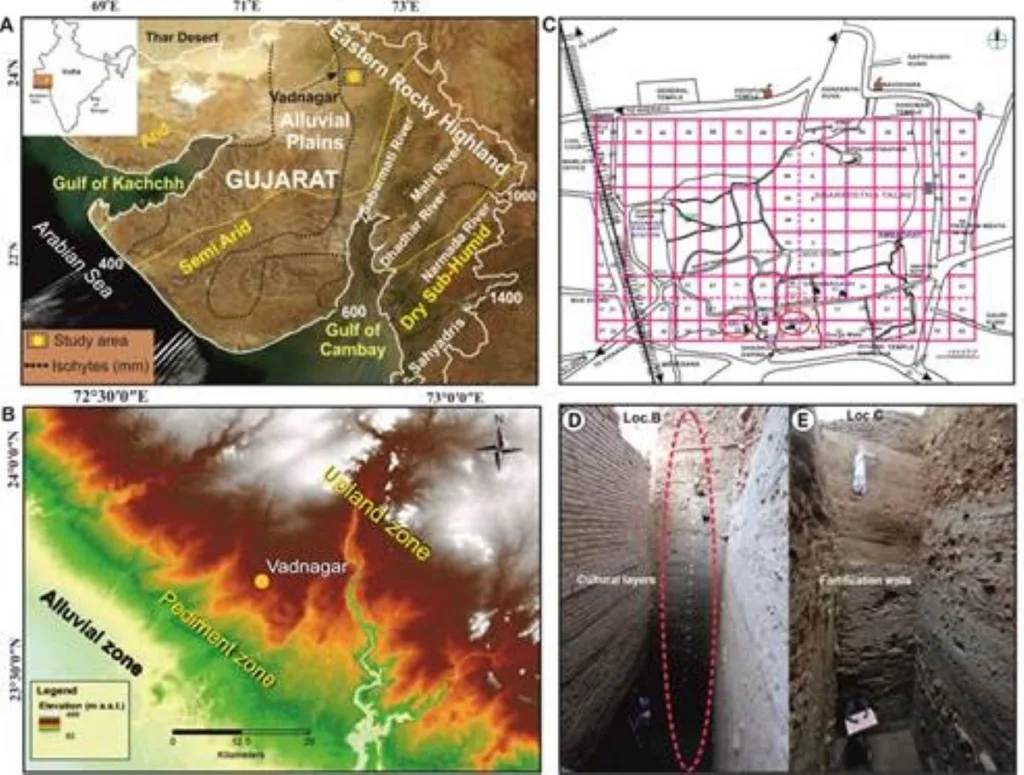According to a new study, the semi-arid Gujarat region’s Vadnagar site experienced mild to intense monsoon precipitation during the Historic and Medieval periods, respectively, and a resilient crop economy based on small-grained cereals (millets; C4 plants) during the post-medieval period (1300-1900 CE; LIA) reflected human adaptation in response to a protracted weakening of the summer monsoon. The work can contribute to the development of future adaption measures to climate change.
Owing to the critical importance of the ISM in the Indian context, its variability in the past and its influence on the early civilizations has not been studied extensively in archaeological context. Further, the rarity of Historic sites, systematic excavations, and multi-disciplinary work in the subcontinent, obscure the impact of distinct climate anomalies in the past. The intensity of the ISM precipitation varies over the Indian landmass, due to the variations in latitude, altitude, and distance from the sea.
Scientists have been tracing historical data on variations of rainfall and its consequences as such studies on changing cropping pattern, vegetation, and cultural development, during last 2000 yrs. provide clues for past human response to climate change and important lessons for modern societies in exploring possible strategies to future climate change.

A team of researchers from Birbal Sahni Institute of Palaeosciences (BSIP), an autonomous institution of Department of Science and Technology presented a circa (ca) 2500-year human occupation sequence spanning multiple environmental changes at the Vadnagar archaeological site based on archaeological, botanical, and isotopic data.
The multiproxy study published in Quaternary Science Advances explores the periods of dynastic transitions and crop harvesting in semi-arid northwest India during past Northern Hemisphere climate events, namely the Roman Warm Period (RWP, 250 BCE-400 CE), Medieval Warm Period (MWP, 800 CE-1300 CE) and Little Ice Age (LIA, 1350 CE-1850 CE).
The data from the site indicate that food production was maintained, even during climate deterioration. It was based on archaeobotanical which combines botanical knowledge with the archaeological material. Besides macro botanical remains, micro botanical (phytolith), and isotope and radiocarbon dating of the grains and charcoal were also included in the study. Archaeological settlements have a potential to play a significant role as the region is known to respond to sharp climatic (monsoonal) changes owing to location in the north-western periphery of southwest monsoonal activity in India. Further, plants used by ancients provide direct evidence of their choices, activities, and ecological conditions.
The combined analysis has enabled an assessment for diversification of food crops and resilient socio-economic practices during the past two millennia in the wake of increasing precipitation and period of weakened monsoon (drought) that affected globally. The results have implications for studies linking past climate changes and historic period famines, indicating that these were in part driven by institutional factors, rather than climate deterioration alone.
Publication link: https://doi.org/10.1016/j.qsa.2023.100155.
